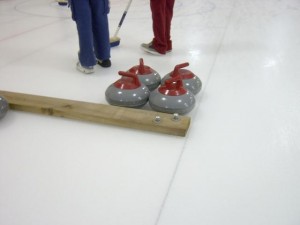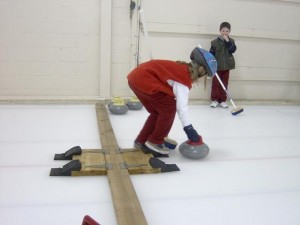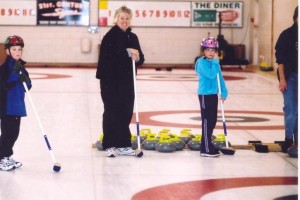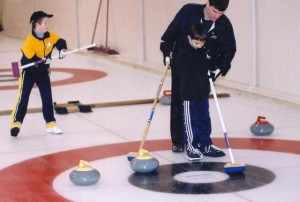Pebbles to Boulders: Adaptation
Way back when, sports started to modify big boy activities so that the little people could play. It was not practical for little bodies to play sports with equipment and playing areas designed for adult sized participants. By modifying equipment to a smaller size, kids could be entrenched with sport at an earlier age to have a longer life long-experience with the healthy pursuits of sport.
In youngsters hockey you play across the ice sheet. Soccer you play on smaller surfaces and the net is greatly reduced in size. Baseball uses smaller balls, bats and gloves, plus the diamond is reduced in size. Basketball uses smaller balls and smaller court sizes, plus lower the height of the basket.
Now enter curling! Jam can curling! The cement filled, iron handled, tin cans thrown down the ice surface… what fun and the whole family could play too. But there was something missing. These tin cans just did not look and sound like the curling Mom and Dad played.
Then in the 1980’s small rocks came along, appropriately called Little Rocks. Reduced in size and weight curling rocks of several varieties, made of plastic and some made of granite. So now problem solved; what the little curlers play with look like real curling rocks (although they did not curl very much) and the kids are happy.
Little Rock programs started springing up all over Canada. But what was found, that the really little kids could not throw the rocks full length of the ice. So here is the solution, “Way we go kids, drag the rocks half-way down the sheet and throw them back to the house at this end and when you are done, we’ll drag all the rocks back again to do it all over again. Now isn’t the fun!”
Wait a minute, something is missing here! When my Mom and Dad curl, after all the rocks are collected at one end, they turn around to throw them back. They throw rocks in two directions at two houses painted on the ice. There is none of this throwing rocks in one direction and having to drag rocks back to play again. The simple solution for the Little Rockers is to paint more circles on the same sheet of ice.
By dividing the regular curling ice sheet in half with painted circles and proper hacks, the quality of the curling experience is more real and the time spent on dragging rocks back and forth is better spent on developing techniques to improve skills. And it is more fun!
Here is how we do it….
The Half-Way Hack
Preferred lumber is cedar – does not warp with moisture, will remain flat and straight
a. One 14 foot length of 2”x6” or 2×8”, stretched across the ice sheet
b. Two 18” lengths of 2”x10”, to support the hacks
c. Two large 4.5” hinges, to anchor the hack support to the 14 footer
d. Two rubber hacks screwed to the hack support, just like regular hacks, to the outside edge and 6” apart.
e. Four 3/16” or larger diameter carriage bolts to pin the whole unit to the ice
f. Package of brass screws to fasten the hinges and the hacks
The 14 footer is placed in the exact middle of the ice sheet, inside the sidelines, anchored at each end with two carriage bolts with pre-drilled holes in the 14 footer and the ice surface. The carriage bolts pin the whole unit to the ice. Caution, rinks with sand floors; do not drill too deep, so not to pierce the brine lines with the drill bit.
(Suggestion, at the time of ice installation, place a metal plate on the sand at the location where the holes in the ice / pins would be located, to provide a solid barrier from the drill bit going too deep. The cold metal plate will not affect ice making and surface conditions, besides it is off to the sidelines if there is any slight temperature variations and will not interfere with playing conditions down the middle of the surface)
A one-inch deep hole will secure the hack enough to support the Little Rockers body weight during delivery. (You will be surprised) The pre-drilled holes in the ice are off to the side of the sheet, so not to interfere with regular curling activity when the halfway hacks are not in use. The hacks are hinged to the middle of the 14 footer so all the parts will lay flat on the ice and to aid in flexibility for storage when not in use. The middle of the hack is positioned on the centre line. Do not worry about ‘rocks bruising’ the ice in the middle of the sheet. The Little Rockers are taught the no-lift delivery, therefore no rocks are smashing down to the ice surface during delivery.
The Half-Way Houses
It is easy to locate the Little Rock houses in the middle of the ice sheet. The hog-line will be a common line for both houses. Measure 21 feet from the hog-line to locate the new tee-line. Where the Tee-line and the centre line intersect is the pin location. Make your house the same way you do for the other houses. After painting the rings, add the back-line. Remember the location of the halfway hack? It is in the exact middle of the ice sheet. You will see that it is naturally located within inches of the proper location for the new house. (Even the keenest eye will not be able to tell that the hack distance is not located just right, and the kids do not mind.)
There you have it. Two Little Rock sheets of ice within one regulation curling ice sheet. The Little Rockers can now throw both ways, just like the adults. You will be amazed to see the accuracy of the smallest Little Rockers when they do not have to forcefully throw a rock the full length of the ice.
As the Little Rockers grow in size and strength, they will be able to develop their skills to one-day throw the rock the full length of the ice. For now, they have their own (Little Rock) ‘regulation’ ice surface. Some adults may comment that the additional houses on the ice are a visual distraction. These houses are no more of a distraction than any club logo or sponsors crest placed in the ice surface. These additional houses will certainly add to the colour of the entire ice rink, but even more important to note, no curler is inconvenienced from playing their game once the hack unit is stored away.
So now if you want to make a three quarter length ice surface, just take one of the extra houses, add another back-line to the other side of the house and measure six feet behind the house to locate the hack position. When Little Rockers graduate from halfway hacks, they can progress to three quarters and eventually full length.
Remember, it is all about making the curling experience for the kids as natural as possible. The manufacturers of Little Rocks did their part to down size curling rocks; it is within the capability of the curling clubs and icemakers to down size the ice surface, to do their part. Curling clubs can adapt and you’ll notice a wonderful change in your young curlers as they improve and have fun.








